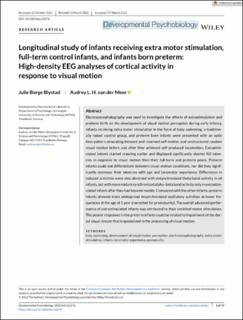| dc.contributor.author | Blystad, Julie Borge | |
| dc.contributor.author | Van der Meer, Audrey | |
| dc.date.accessioned | 2022-11-28T09:00:38Z | |
| dc.date.available | 2022-11-28T09:00:38Z | |
| dc.date.created | 2022-05-05T10:49:49Z | |
| dc.date.issued | 2022 | |
| dc.identifier.issn | 0012-1630 | |
| dc.identifier.uri | https://hdl.handle.net/11250/3034363 | |
| dc.description.abstract | Electroencephalography was used to investigate the effects of extrastimulation and preterm birth on the development of visual motion perception during early infancy. Infants receiving extra motor stimulation in the form of baby swimming, a traditionally raised control group, and preterm born infants were presented with an optic flow pattern simulating forward and reversed self-motion and unstructured random visual motion before and after they achieved self-produced locomotion. Extrastimulated infants started crawling earlier and displayed significantly shorter N2 latencies in response to visual motion than their full-term and preterm peers. Preterm infants could not differentiate between visual motion conditions, nor did they significantly decrease their latencies with age and locomotor experience. Differences in induced activities were also observed with desynchronized theta-band activity in all infants, but with more mature synchronized alpha–beta band activity only in extrastimulated infants after they had become mobile. Compared with the other infants, preterm infants showed more widespread desynchronized oscillatory activities at lower frequencies at the age of 1 year (corrected for prematurity). The overall advanced performance of extrastimulated infants was attributed to their enriched motor stimulation. The poorer responses in the preterm infants could be related to impairment of the dorsal visual stream that is specialized in the processing of visual motion. | en_US |
| dc.description.abstract | Longitudinal study of infants receiving extra motor stimulation, full-term control infants, and infants born preterm: High-density EEG analyses of cortical activity in response to visual motion. | en_US |
| dc.language.iso | eng | en_US |
| dc.publisher | Wiley | en_US |
| dc.relation.uri | https://doi.org/10.1002/dev.22276 | |
| dc.rights | Attribution-NonCommercial-NoDerivatives 4.0 Internasjonal | * |
| dc.rights.uri | http://creativecommons.org/licenses/by-nc-nd/4.0/deed.no | * |
| dc.title | Longitudinal study of infants receiving extra motor stimulation, full-term control infants, and infants born preterm: High-density EEG analyses of cortical activity in response to visual motion. | en_US |
| dc.title.alternative | Longitudinal study of infants receiving extra motor stimulation, full-term control infants, and infants born preterm: High-density EEG analyses of cortical activity in response to visual motion. | en_US |
| dc.type | Journal article | en_US |
| dc.type | Peer reviewed | en_US |
| dc.description.version | publishedVersion | en_US |
| dc.source.volume | 64 | en_US |
| dc.source.journal | Developmental Psychobiology | en_US |
| dc.source.issue | 5 | en_US |
| dc.identifier.doi | https://doi.org/10.1002/dev.22276 | |
| dc.identifier.cristin | 2021684 | |
| cristin.ispublished | true | |
| cristin.fulltext | original | |
| cristin.qualitycode | 1 | |

